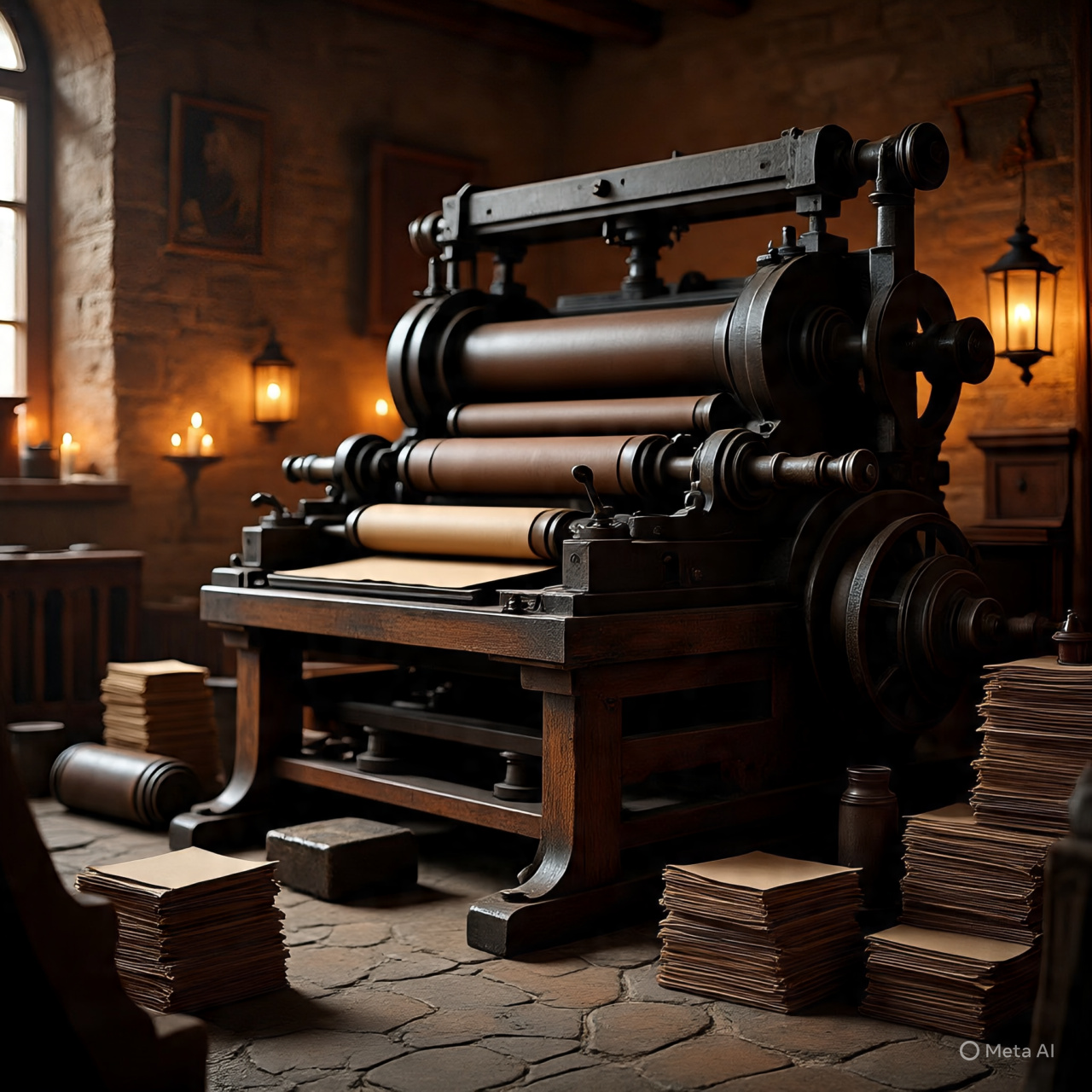Introduction: The World-Changing Invention of Printing
The printing press stands as one of humanity’s most transformative inventions, revolutionizing how knowledge is preserved and disseminated. This comprehensive guide traces the complete evolution of printing from its earliest precursors to today’s cutting-edge technologies and explores future possibilities that could further reshape our world.
Unlike previous communication revolutions that took centuries to unfold, the printing press created an immediate and lasting impact on human civilization. Its development represents a fascinating intersection of technology, culture, and commerce that continues to evolve today in surprising ways.
Chapter 1: The Dawn of Printing – Pre-Gutenberg Innovations
Ancient Printing Methods (2000 BCE – 1400 CE)
Long before Gutenberg, various civilizations developed early forms of printing:
1. Cylinder Seals (Mesopotamia, 3000 BCE)
-
First known printing devices
-
Used to create impressions in clay
-
Primarily for authentication rather than mass communication
2. Woodblock Printing (China, 200 CE)
-
Earliest method of printing on paper
-
Entire pages carved into wooden blocks
-
Used extensively for Buddhist texts and artwork
-
The Diamond Sutra (868 CE) – oldest surviving printed book
3. Movable Type Innovations
-
Bi Sheng (1040 CE, China): Created ceramic movable type
-
Wang Zhen (1298 CE, China): Developed wooden movable type
-
Korean Metal Type (1234 CE): First known use of metal movable type
These early technologies spread slowly due to:
-
The complexity of Asian writing systems
-
Limited demand for mass reproduction
-
High production costs
Chapter 2: Gutenberg’s Revolution (1440-1500)
Johannes Gutenberg: The Man Behind the Revolution
Born in Mainz, Germany around 1400, Gutenberg combined several existing technologies to create his revolutionary press:
Key Components of Gutenberg’s Press:
-
Movable Metal Type: Alloy of lead, tin, and antimony
-
Oil-Based Ink: Superior adhesion to metal type
-
Modified Wine Press: Provided even pressure
-
Type Mold: Enabled mass production of identical letters
The Gutenberg Bible (1455)
-
First major printed work in the West
-
Printed in Latin (Vulgate version)
-
Approximately 180 copies produced
-
48 known surviving copies today
-
Valued at $25-35 million per copy
Immediate Impact (1450-1500)
-
Printing Spread Across Europe:
-
1465: Italy
-
1470: France
-
1476: England (William Caxton)
-
-
Estimated 20 million books printed by 1500
-
Rapid decline in book prices (from months’ wages to days’ wages)
Chapter 3: The Printing Revolution Expands (1500-1800)
Key Developments in Early Modern Printing
1. The Protestant Reformation (1517)
-
Martin Luther’s 95 Theses spread via printing
-
First “viral” media campaign in history
-
Printed vernacular Bibles undermined Church authority
2. Scientific Revolution
-
Rapid sharing of scientific discoveries
-
Standardization of technical diagrams
-
Peer review becomes possible
3. Newspapers Emerge (1605)
-
Relation (Strasbourg) – first newspaper
-
Weekly publications spread across Europe
-
Birth of modern journalism
4. Technological Improvements
-
Better type alloys
-
Improved press designs
-
More durable paper
Chapter 4: The Industrial Revolution of Printing (1800-1900)
Mechanical Printing Innovations
1. The Stanhope Press (1800)
-
First all-metal press
-
Increased printing speed
-
Stronger impression
2. The Koenig Steam Press (1814)
-
First steam-powered printing machine
-
Used by The Times of London
-
Could print 1,100 sheets/hour
3. Rotary Press (1843)
-
Invented by Richard March Hoe
-
Continuous roll of paper
-
8,000 sheets/hour capacity
4. Linotype Machine (1884)
-
Ottmar Mergenthaler’s invention
-
Automated typesetting
-
Revolutionized newspaper production
Cultural Impact
-
Mass literacy becomes possible
-
Public education systems develop
-
National identities strengthen
-
Modern advertising emerges
Chapter 5: 20th Century Printing Technologies
Offset Lithography (1904)
-
Ira Rubel’s accidental discovery
-
Image transferred from plate to rubber blanket
-
Became dominant commercial printing method
Screen Printing (1910s)
-
Popularized by Andy Warhol
-
Used for posters, textiles, electronics
Photocopying (1938)
-
Chester Carlson’s xerography
-
Led to modern office copiers
Digital Revolution (1970s-1990s)
-
Laser printing (1971)
-
Desktop publishing (1985)
-
PDF format (1993)
Chapter 6: 21st Century Printing Innovations
Digital Printing Advances
-
HP Indigo (1993)
-
Variable data printing
-
Web-to-print services
3D Printing Revolution
-
Stereolithography (1984)
-
Fused deposition modeling (1988)
-
Current applications:
-
Aerospace
-
Medical implants
-
Automotive
-
Construction
-
Nanographic Printing
-
Landa Nanography (2012)
-
Combines offset and digital advantages
-
Ultra-high resolution
Chapter 7: The Future of Printing Technology
Emerging Technologies
1. 4D Printing
-
Self-assembling materials
-
Time-dependent shape changes
-
Potential applications:
-
Adaptive clothing
-
Smart infrastructure
-
2. Bioprinting
-
Organ and tissue fabrication
-
Current challenges:
-
Vascularization
-
Cell viability
-
-
Recent breakthroughs:
-
3D-printed skin
-
Mini-hearts
-
3. Molecular Printing
-
Manipulating matter at atomic level
-
Potential for custom molecules
-
Pharmaceutical applications
4. AI-Optimized Printing
-
Generative design
-
Predictive maintenance
-
Automated quality control
Sustainability Trends
-
Plant-based inks
-
Recyclable substrates
-
Energy-efficient processes
-
Circular economy models
Conclusion: Printing’s Enduring Legacy
From Gutenberg’s workshop to modern bioprinting labs, printing technology continues to shape human civilization in profound ways. As we stand on the brink of new breakthroughs in nanotechnology, biotechnology, and artificial intelligence, the fundamental concept of printing – the precise arrangement of matter to convey information – remains more relevant than ever.
The next chapter in printing’s history may involve:
-
Printed human organs saving lives
-
Smart materials that adapt to environments
-
Sustainable production methods
-
Space-based manufacturing
As we’ve seen through 600 years of printing history, each advancement creates ripple effects across society, culture, and technology. The future of printing promises to be just as revolutionary as Gutenberg’s original invention.



Leave a Reply